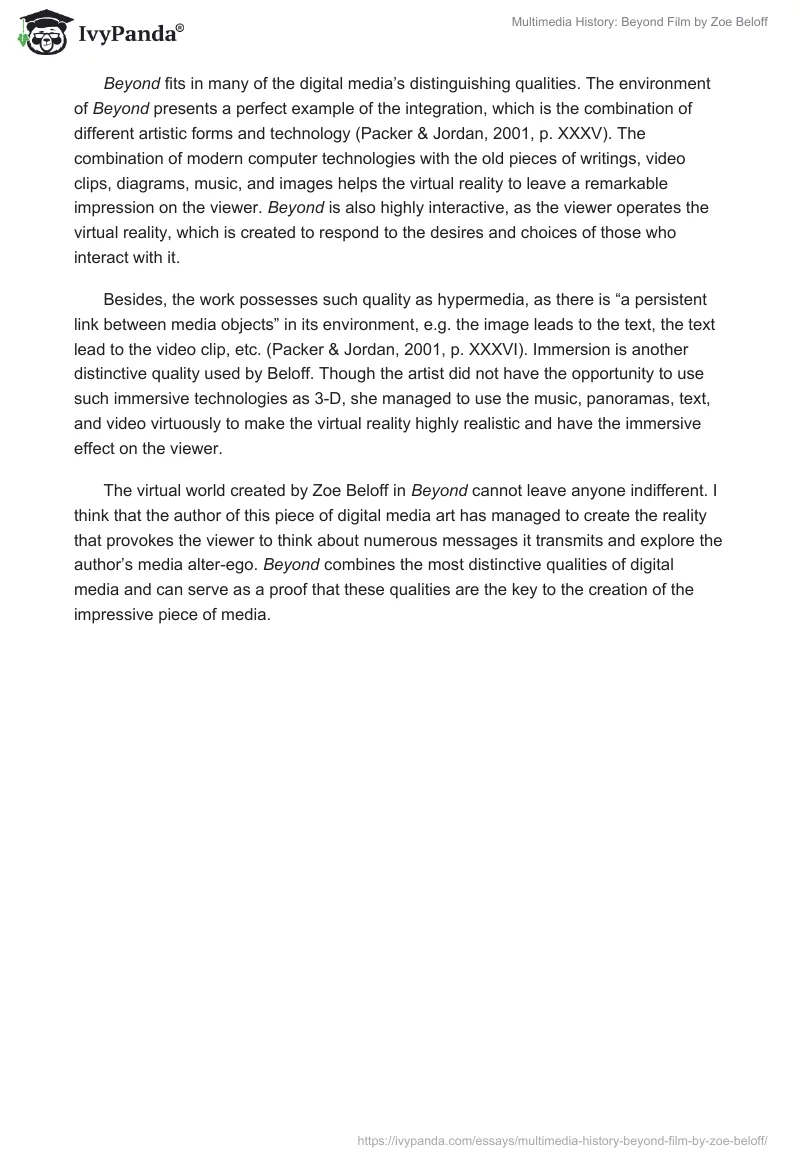Zoe Beloff is famous all over the world for her works based on the usage of different types of media (Biography, n.d.). Beyond is one of her amazing installations that have deserved a wide appreciation among critics and art lovers. In this essay, I will demonstrate that the virtual world of Beyond presents a perfect combination of the most distinguishing qualities of digital media and serves as an example of successful usage of these qualities for the creation of the outstanding piece of media art.
The experience of interacting with Beyond is unique and cannot be compared to anything else. The virtual reality contains twenty Quicktime virtual realities panoramas and eighty clips. By clicking on various elements of the reality, the viewer has an opportunity to read the important notes, change the images, and move through the different levels of the virtual world by exploring numerous intersections between the past and the present, the mind and the technology. Interacting with Beyond gives a unique experience of exploring the phenomenon called by Beloff a “mental geography,” in which the viewer can travel through time and space and learn the author’s alter-ego combining the ideas belonging to the living and the dead (Beloff, 2002, p. 290).
The ideas reflected in Beyond are related to the author’s exploration of dream life of technology since the birth of media technology in 1850 and till 1940 when the technological advances led to the creation of means of mass slaughter. The location presented in the virtual reality is an abandoned nineteenth-century asylum that stands for numerous significant places associated with the period explored in Beyond.
The digital movie clips are mostly the fragments of the home movies of the beginning of the twentieth century and early film footage (Beloff, 2002, p. 290). The author blends such fragments with the old diagrams, the poems of Charles Pierre Baudelaire, and the mysterious music to provoke the viewer to find the connection between the forgotten past and the present and uncover the magic of the nineteenth century (Beloff, 1995-1997). Beloff encourages the viewer to find the origins of the present in the magnificent and forgotten past and explore the theme of death and artificial resurrection (Beloff, 2002, p. 293).
Beyond fits in many of the digital media’s distinguishing qualities. The environment of Beyond presents a perfect example of the integration, which is the combination of different artistic forms and technology (Packer & Jordan, 2001, p. XXXV). The combination of modern computer technologies with the old pieces of writings, video clips, diagrams, music, and images helps the virtual reality to leave a remarkable impression on the viewer. Beyond is also highly interactive, as the viewer operates the virtual reality, which is created to respond to the desires and choices of those who interact with it.
Besides, the work possesses such quality as hypermedia, as there is “a persistent link between media objects” in its environment, e.g. the image leads to the text, the text lead to the video clip, etc. (Packer & Jordan, 2001, p. XXXVI). Immersion is another distinctive quality used by Beloff. Though the artist did not have the opportunity to use such immersive technologies as 3-D, she managed to use the music, panoramas, text, and video virtuously to make the virtual reality highly realistic and have the immersive effect on the viewer.
The virtual world created by Zoe Beloff in Beyond cannot leave anyone indifferent. I think that the author of this piece of digital media art has managed to create the reality that provokes the viewer to think about numerous messages it transmits and explore the author’s media alter-ego. Beyond combines the most distinctive qualities of digital media and can serve as a proof that these qualities are the key to the creation of the impressive piece of media.


